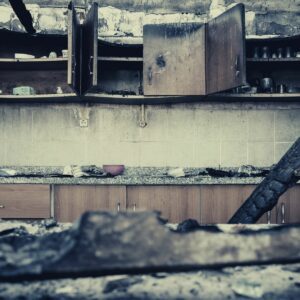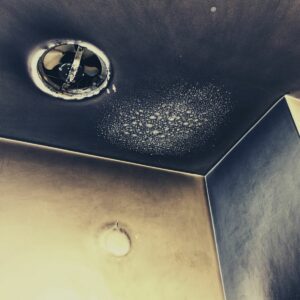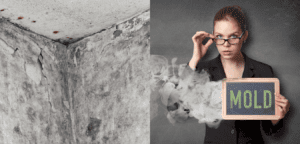Fire And Smoke Damage Restoration
In the initial stages of fire and smoke damage restoration, you may feel like you are decluttering your home – you will go through your belongings and keep the salvageable items while throwing away those beyond repair or destroyed.
As a first step, you need to examine every room in your house to determine if there are any other affected areas.
During this process, you should inspect your ceilings. The walls are usually the sites where smoke damage is most visible when surveying smoke damage. In addition to checking your walls, make sure your ceilings are in good shape as well, as they usually have extensive damage.
Damage caused by smoke is often thought to be permanent, when it is actually repairable. Cleansing smoke damage depends on how much soot is on surfaces and if they are porous or not. Smoke damage to walls, floors, clothes, etc., will have a direct effect on how long it takes for them to be restored to their original state.
Cleaning Smoke Damage
As soon as you’ve determined where the smoke damage is, you can start cleaning. Opening as many windows as possible throughout the house is the first step towards cleaning smoke damage. Ventilation can help limit the damage and speed up the cleaning process, so turn on any fans and blow the air.
When it comes to cleaning smoke damage, it’s important to have all the tools on hand, even the specialized ones. Make sure you have these smoke damage cleaning products available to remove smoke and soot damage from walls, furniture, and other parts of your home.
It’s okay if you don’t have a smoke vacuum or other specialized tools for smoke remediation. Soot that accumulated during a fire can be easily removed using a vacuum cleaner.
The first step in smoke damage restoration is to remove all soot and smoke particles from the affected parts of the floor. You should take precautions to remove soot as soon as possible, as it can be harmful to your lungs and even cause cancer.
While wearing gloves, a mask, and goggles, start off by vacuuming up the loose soot in or around the affected area. It’s best to use a smoke vacuum, or at least a powerful dry-vac for this task. Alternatively, you can use a regular vacuum with an upholstery attachment.
The soot and debris should be vacuumed up gently since running a vacuum cleaner over the smoke-damaged areas is more likely to spread the soot and drive it deeper into the floorboards and walls.
You should now focus on the walls once you have carefully removed all the soot and ash from the ground.
Inspecting the walls for soot particles is the next step. The cleaning of smoke damage is a separate process. Before you begin the important next step, you need to carefully vacuum all of the larger pieces of soot, both on the floor and on the walls.
If not, you may spread unvacuumed soot into your walls while attempting to clean smoke damage. Whenever this happens, call a restoration company with professional soot removal services.
What To Use To Clean The Smoke Damage
The first step is to remove the bulk of the smoke with a dry-cleaning or soot cleaning sponge. These sponges are designed specifically for smoke restoration projects.
Make sure you have several on hand, and use one gently on a dry surface. Rather than using water or cleaners at this point, take the sponge and gently rub it at the affected areas. Be careful not to use the same part of the sponge for more than a few strokes.
You need to use the sponge until there are no areas that aren’t blackened – cut off any remaining surfaces with a knife and start over, or just use a new sponge until you’ve covered the whole surface.
After that, you’ll want to use rags to wipe down the wall with your cleaning solution and warm water. It would be great to use a commercial soot cleaner, but paint thinner or even vinegar in warm water would also be effective.
You will need to use your second bucket filled with warm water once you have cleaned the area. With a degreaser or mild dish soap and hot water, you can finally scrub off the more oil-soluble particles resulting from smoke and soot.
If you have thoroughly cleaned the area using all three of these products, you should rinse the walls down with hot water, to completely remove all of the cleaning products you have used.
In order to clean smoke off walls, you must follow the three steps outlined in the previous section. Use the dry-cleaning sponge to blot every area and remove as much smoke as possible.
In order to avoid streaks and stains, you should clean small areas at a time, starting from the floor and going up to the ceiling. Once you’re finished, make sure you thoroughly rinse the area.
You should dry the walls as soon as you’re done if you have wallpaper so that water won’t soak through. Repainting painted walls after removing soot damage may not be a bad idea.
For Windows, it’s much easier. Use the cloths and soot cleaner to clean the windows, then use the degreaser to remove any remaining residue. If you use a spray bottle, fill the spray bottle with water and add white vinegar. Apply the spray to the glass and let sit for about 5 minutes, then wipe the glass clean. If you have cigarette smoke on your window, the white vinegar in the solution will dislodge the nicotine so that you can easily remove it from your window.
Lastly, you should clean any smoke-damaged ceilings. These steps are the same as in the previous sections. It will be harder to clean the ceiling.
Removing The Smoke Damage Odor
After you have removed the smoke and soot damage, you may still need to remove the smoke smell. Using a bowl of baking soda or vinegar to absorb the odor will be sufficient if the damage was minor. Ozone treatment may be necessary for more prevalent odors.
Safety
Fire damage cleaning situations require everyone’s safety. Fire damage restoration specialists can ensure the safety of those who work on and enter a structure after a fire by taking the necessary precautions. Before evaluating and restoring the structure, it is critical that it is safe.
Call StinkInc today for a free and to set up an appointment if you need our professionals to help you with your smoke damage.



